Islamic Architecture in Spain: A Journey Through Al-Andalus's Timeless Legacy
Standing beneath the forest of red-and-white striped arches in Córdoba's Great Mosque, visitors feel transported through centuries of history. Islamic Architecture in Spain tells a story that transcends borders, religions, and time itself – a testament to human creativity and cultural fusion that continues to captivate travelers from around the world.

Spain's Islamic architectural heritage represents one of Europe's most extraordinary cultural treasures, born from eight centuries of Muslim rule that transformed the Iberian Peninsula into a beacon of learning, art, and architectural innovation.
A Brief History of Al-Andalus
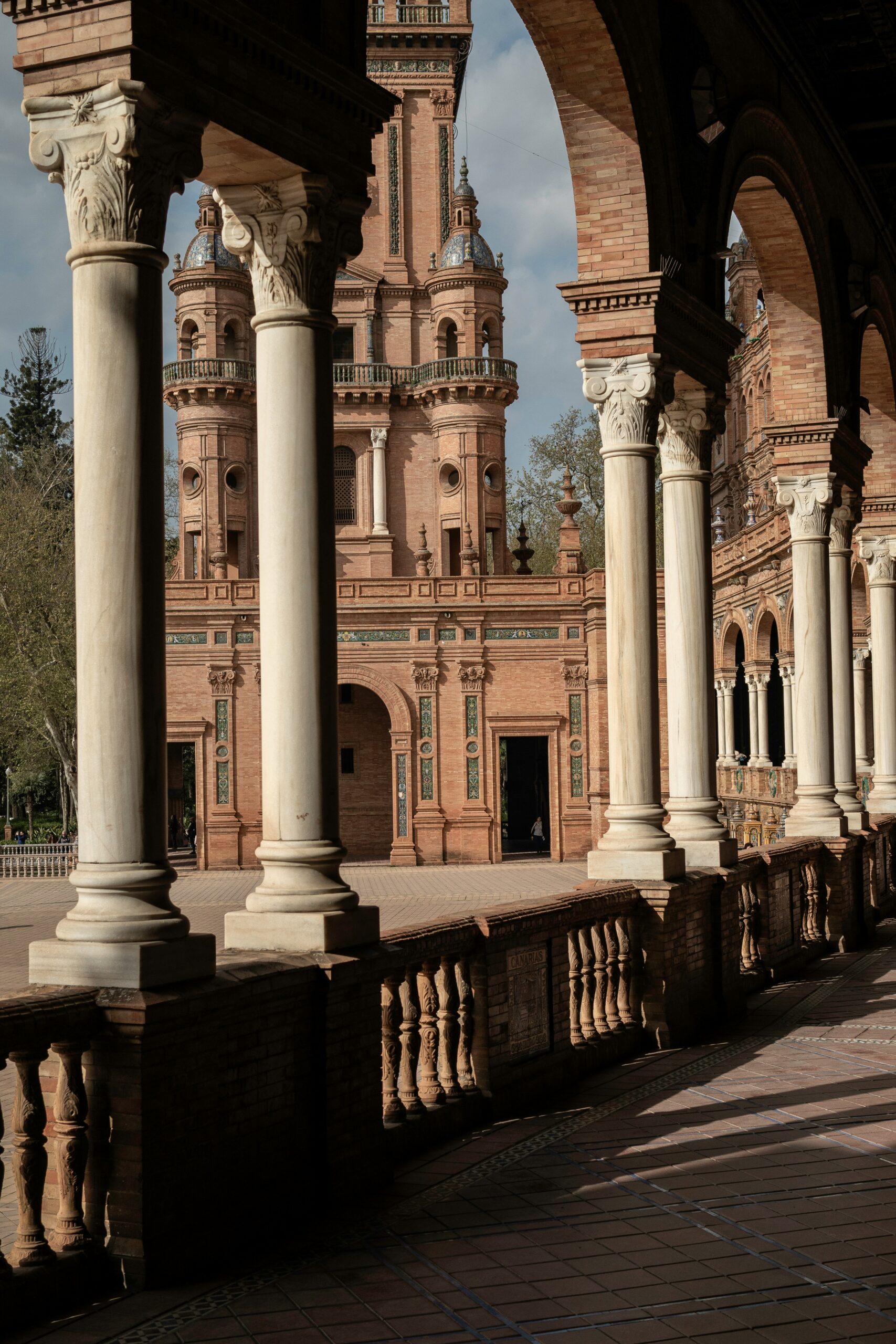
756 AD: Abd al-Rahman I establishes the Umayyad Caliphate in Córdoba
929 AD: Abd al-Rahman III declares himself Caliph
1031 AD: Caliphate collapses, beginning of Taifa period
The story begins in 711 AD when Tariq ibn Ziyad crossed the Strait of Gibraltar, forever changing Spanish history. What followed wasn't merely conquest but transformation – the birth of Al-Andalus, a civilization that would flourish for nearly eight centuries. Under the Umayyad Caliphate, established in Córdoba by Abd al-Rahman I in 756 AD, Islamic Spain became a center of learning rivaling Baghdad and Cairo.
Walking through Córdoba today, you can still sense this golden age's grandeur. The city once boasted over 3,000 mosques, 300 public baths, and libraries containing hundreds of thousands of manuscripts. The Umayyad rulers created something entirely new, blending Islamic traditions with existing Visigothic, Roman, and local influences.
This cultural synthesis reached its zenith during the 10th century under Abd al-Rahman III, who declared himself Caliph in 929 AD. The palace city of Medina Azahara, built outside Córdoba, showcased the empire's wealth and artistic sophistication, setting the foundation for what would become the distinctive characteristics of Islamic Architecture in Spain.
Key Characteristics of Islamic Architecture in Spain
Horseshoe Arches
The horseshoe arch stands as perhaps the most recognizable feature of Islamic Architecture in Spain. More than just structural elements, these arches create rhythmic patterns that guide the eye and spirit through sacred and secular spaces.
Geometric Patterns
Islamic geometric patterns serve both decorative and spiritual purposes, based on mathematical principles creating infinitely repeating patterns that reflect Islamic concepts of divine unity.
Water Features
Water plays a central role, serving practical, aesthetic, and symbolic purposes while creating cooling microclimates and promoting contemplation.
Horseshoe Arches and Geometric Mastery
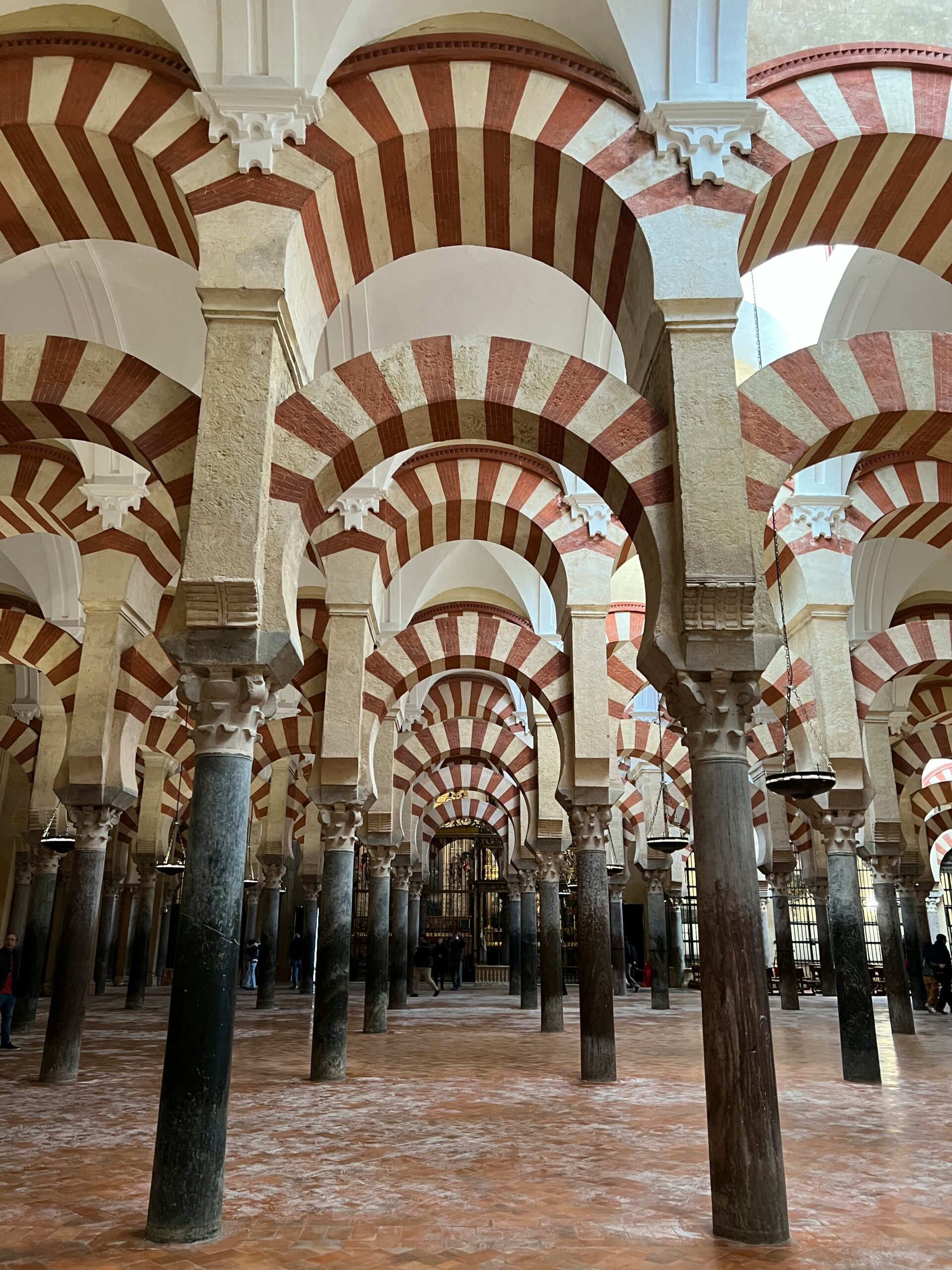
The horseshoe arch stands as perhaps the most recognizable feature of Islamic Architecture in Spain. More than just structural elements, these arches create rhythmic patterns that guide the eye and spirit through sacred and secular spaces. In the Mezquita of Córdoba, endless rows of horseshoe arches create a forest-like canopy transforming the vast interior into an intimate, contemplative space.
Islamic geometric patterns in Spanish architecture serve both decorative and spiritual purposes. Based on mathematical principles creating infinitely repeating patterns, these designs reflect Islamic concepts of divine unity and Allah's infinite nature. The Alhambra's walls showcase thousands of variations on basic geometric themes – stars, polygons, and interlacing lines creating mesmerizing visual symphonies.
Water, Light, and Sacred Calligraphy
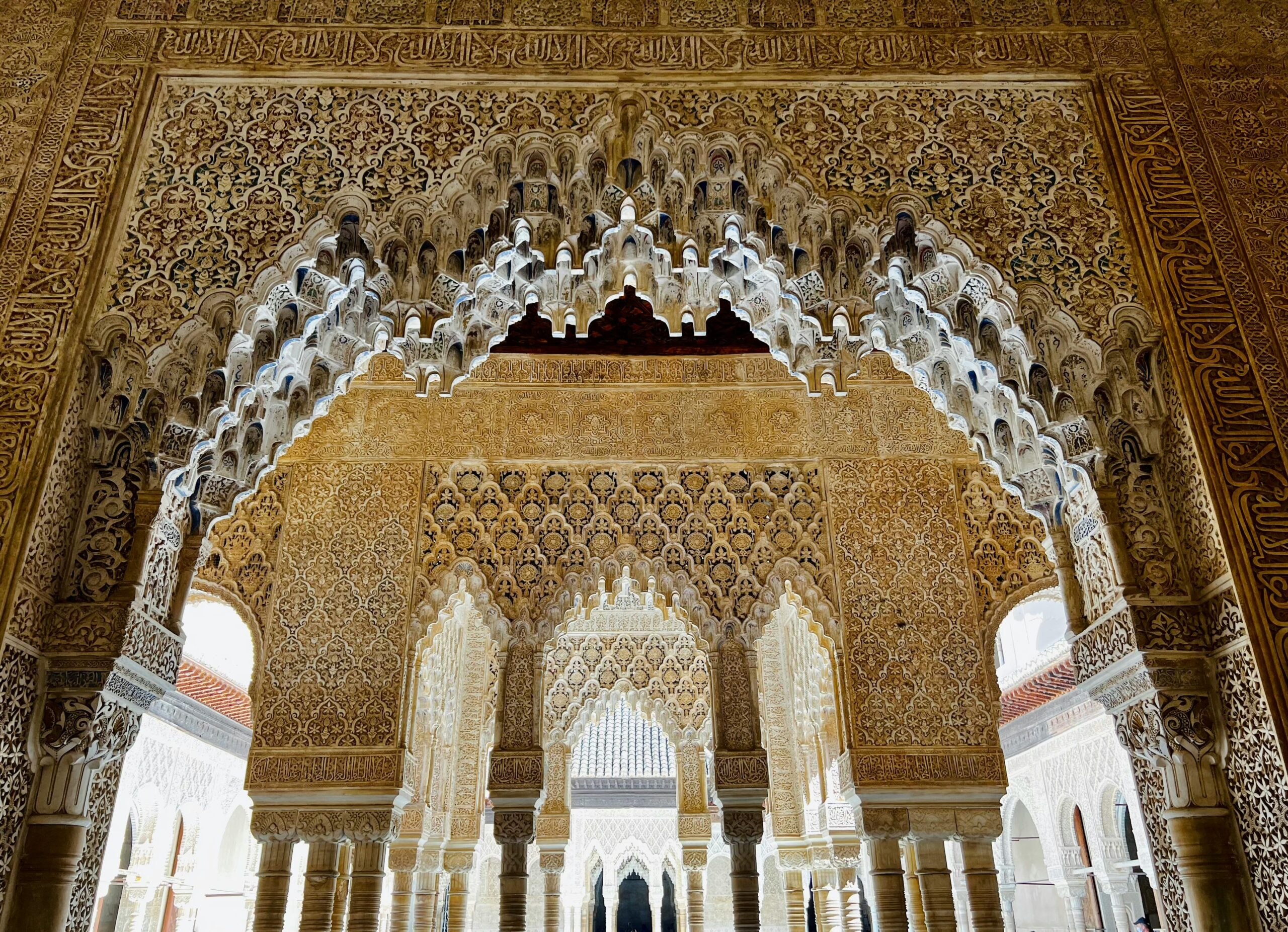
Water plays a central role in Islamic Architecture in Spain, serving practical, aesthetic, and symbolic purposes. The Alhambra's Court of Lions exemplifies this tradition, where fountains create cooling microclimates while their gentle sounds mask conversations and promote contemplation. Water channels throughout Islamic Spanish buildings connect interior and exterior spaces, creating unified environments.
Arabic calligraphy transforms architectural surfaces into readable prayers and poetry. In the Alhambra's Palace of Comares, inscriptions proclaim "There is no victor but Allah" while poems describe the palace's own beauty. This integration of text and architecture creates buildings that literally speak to visitors, sharing their history and spiritual significance.
Muqarnas and Decorative Arts
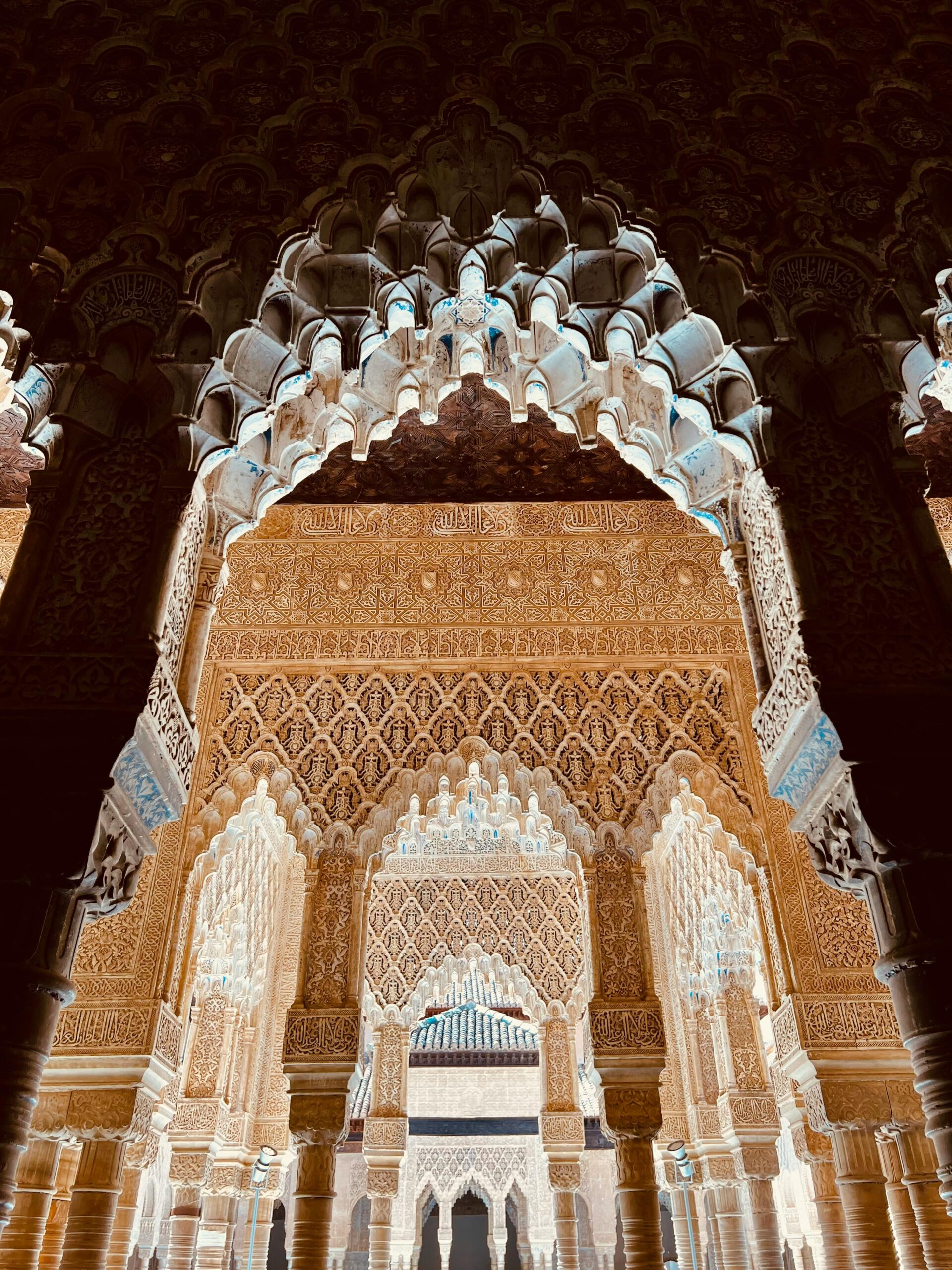
Muqarnas – elaborate honeycomb vaulting systems – represent one of Islamic architecture's most distinctive features. In Spanish examples like the Alhambra's Hall of Ambassadors, muqarnas transform flat ceilings into complex three-dimensional sculptural compositions seeming to defy gravity. Spanish muqarnas often incorporate painted decoration and gilt details that enhance their visual impact.
Zellij – intricate mosaic tilework – covers walls, floors, and architectural elements throughout Spanish Islamic buildings. Each piece is hand-cut and assembled into complex geometric patterns creating shimmering surfaces that catch and reflect light. The technique, perfected in Al-Andalus, requires extraordinary skill and mathematical precision.
Architectural Masterpieces
The Great Mosque of Córdoba (Mezquita)
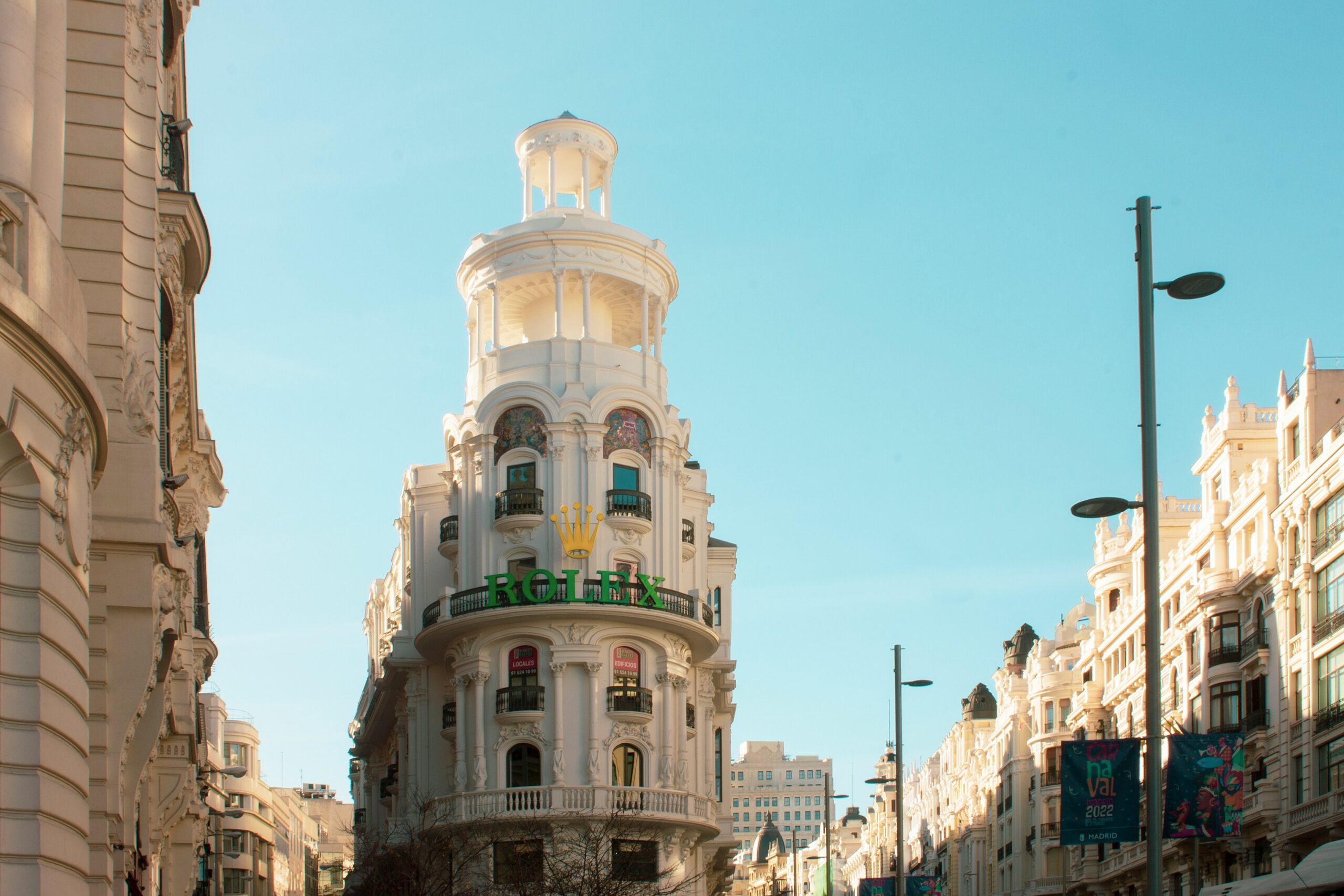
The Mezquita of Córdoba stands as one of the world's architectural wonders, embodying centuries of cultural evolution. Built on a Visigothic church site, the mosque's initial construction began in 784 AD under Abd al-Rahman I. The mosque's famous double-tier arch system – alternating red brick and white stone – creates one of architecture's most memorable interiors.
The Mezquita grew through four major expansions, each adding architectural innovations while maintaining overall harmony. The most spectacular addition came under Al-Hakam II in 961 AD, who created the magnificent mihrab area with intricate mosaics and polylobed arches. Byzantine craftsmen worked alongside local artisans to create decorative schemes rivaling anything in the Islamic world.
Following Córdoba's conquest by Ferdinand III in 1236, the mosque was consecrated as a cathedral. In the 16th century, a Renaissance cathedral nave was built within the mosque's center, creating one of history's most striking examples of cultural layering. Today, the Mezquita-Cathedral serves as both active cathedral and UNESCO World Heritage Site, representing the pinnacle of Islamic Architecture in Spain.
Find Hotels in Córdoba
The Alhambra Palace, Granada
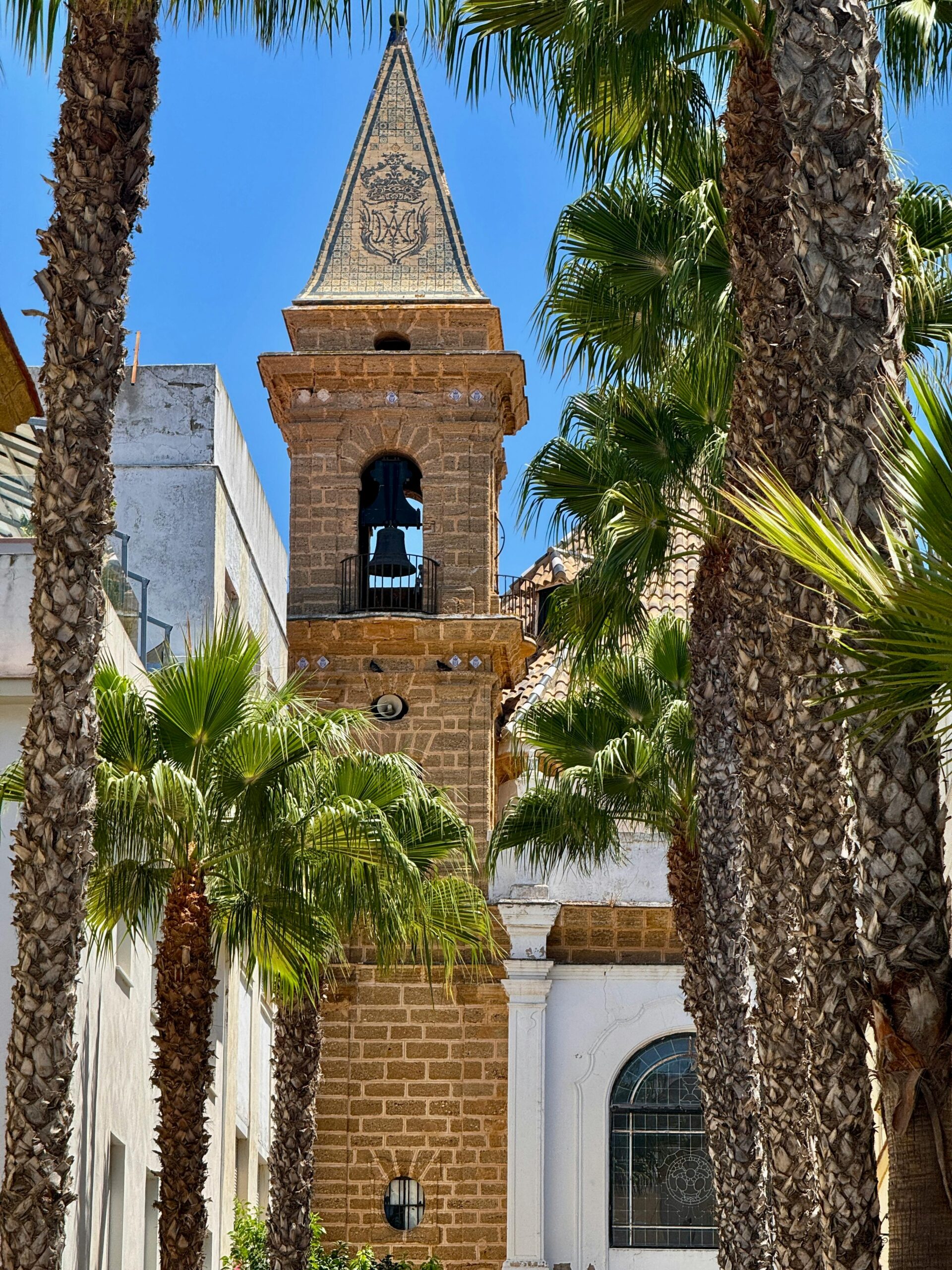
Perched on Granada's Sabika Hill, the Alhambra represents the final flowering of Islamic Architecture in Spain. Built primarily during the 13th and 14th centuries by Nasrid rulers, this palace complex transforms defensive necessity into earthly paradise. The name "Alhambra" derives from "Al-Qala'a al-Hamra," meaning "the Red Fortress."
The Nasrid Palaces – Mexuar, Comares, and Lions – demonstrate sophisticated understanding of architectural psychology. Each space serves specific ceremonial functions while creating emotional experiences through carefully orchestrated sequences of light, shadow, water, and decoration. The Palace of Comares overwhelms visitors with its scale and decorative richness, while the Palace of Lions provides intimate spaces for reflection.
The Court of Lions stands as perhaps the most photographed space in Islamic architecture, yet its fame doesn't diminish its power to astonish. Twelve marble lions support the central fountain, while slender columns create porticoes that seem to float above the courtyard. What makes the Alhambra truly unique is its "self-commentating" architecture – inscriptions that describe the buildings themselves, creating buildings that literally speak about their own beauty.
Find Hotels in Granada
La Giralda, Seville
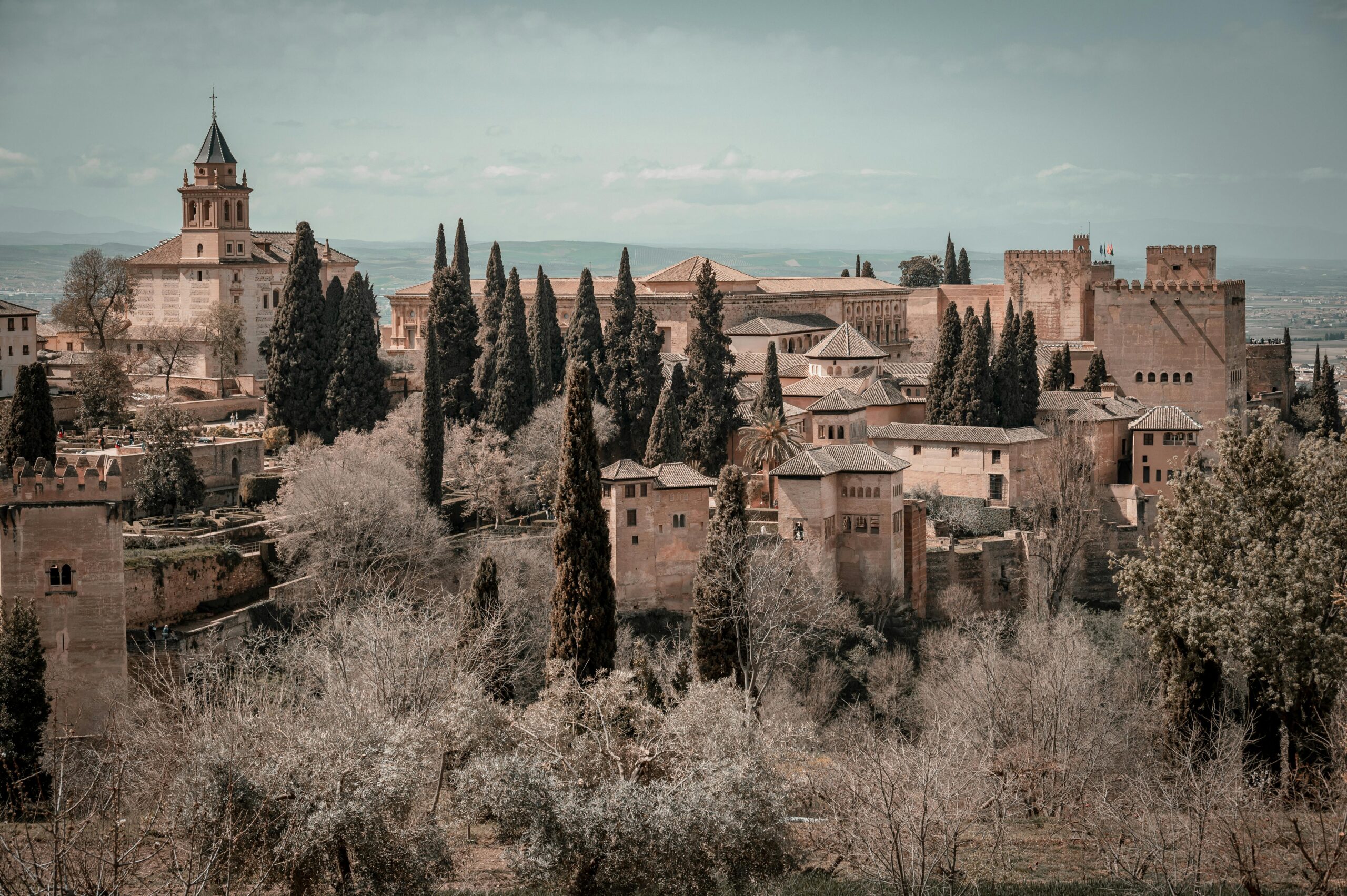
Seville's Giralda tower embodies architectural transformation, beginning life as an Almohad minaret before becoming a Christian bell tower. Built between 1184 and 1198, the tower originally served the Friday Mosque, one of the Islamic world's largest religious complexes. The Giralda's distinctive decoration – geometric patterns in brick relieved by blind arches – established a model copied throughout Islamic Spain and North Africa.
Following the Christian conquest of Seville in 1248, the mosque was demolished, but the Giralda's beauty saved it from destruction. Christian authorities added a bell chamber and weathervane that gave the tower its current name, creating a harmonious integration of Islamic base and Renaissance addition.
The Aljafería Palace, Zaragoza
Often overshadowed by more famous monuments, the Aljafería Palace represents one of Spain's finest examples of 11th-century Islamic architecture. Built by Ahmad al-Muqtadir for the Taifa kingdom of Zaragoza, the palace demonstrates how political fragmentation spurred architectural innovation.
The palace's golden age room, with intricate stucco decoration and polylobed arches, rivals anything at the Alhambra. The geometric patterns and calligraphic inscriptions show sophisticated artistic development that influenced later developments in Islamic Architecture in Spain. The palace's prayer room, with its remarkable mihrab, demonstrates how even small spaces could achieve monumental effects.
Other Notable Treasures
Medina Azahara (Córdoba): The archaeological site offers glimpses into lost Umayyad palace splendor. Built by Abd al-Rahman III in 936 AD, this palace city housed the caliph's court in settings of unprecedented luxury, showcasing early developments in Islamic Architecture in Spain.
Alcazaba of Málaga: This coastal fortress demonstrates how Islamic military architecture adapted to specific geographic conditions, creating beautiful residential spaces within secure walls while maintaining strategic control over Mediterranean trade routes.
Alcázar of Seville: Representing the finest flowering of Mudéjar architecture, this palace complex demonstrates how Islamic architectural traditions continued under Christian patronage, creating a distinctive fusion style that became characteristic of later Spanish architecture.
Arab Baths of Ronda: These 13th-century baths provide rare insights into daily life during Islamic Spain, demonstrating sophisticated hydraulic engineering that supplied water to Islamic cities while creating beautiful spaces for daily activities.
The Lasting Influence
Mudéjar Architecture: Cultural Fusion
The Mudéjar style represents one of architectural history's most successful cultural fusions. When Christian kingdoms reconquered Islamic territories, they faced practical questions about existing buildings and traditions. The pragmatic answer created Mudéjar – a distinctive architectural style employing Islamic decorative techniques within Christian building programs.
Mudéjar buildings like Toledo's San Román church demonstrate how Christian patrons appreciated Islamic artistic traditions enough to commission new buildings in Islamic styles. The style spread throughout Spain and its colonies, influencing architecture from Mexico to the Philippines, demonstrating how Islamic architectural traditions spread far beyond their original boundaries.
Modern Influence and Sustainability
Contemporary architects increasingly appreciate sustainable design principles embedded in Islamic Architecture in Spain. The passive cooling systems used in Islamic Spanish buildings – courtyards, water features, and strategic window placement – provide models for sustainable design in hot climates.
The modular geometric systems developed for Islamic decorative patterns inspire contemporary parametric design approaches. Modern resort architecture often adapts Islamic architectural principles, using courtyards, water features, and shading systems derived from Islamic precedents while adapting these features for contemporary functions.
Cultural Legacy Beyond Buildings
The cultural fusion that created Islamic Architecture in Spain extended to all aspects of life. Spanish language contains thousands of words derived from Arabic, while Spanish cuisine incorporates ingredients and techniques introduced during Islamic rule. Traditional Spanish arts like metalwork, ceramics, and textiles show clear Islamic influences, with the azulejo tile tradition deriving directly from Islamic decorative traditions.
Visiting Spain's Islamic Architectural Wonders
Planning Your Travel
Planning visits to Spain's Islamic architecture destinations requires considering both climate and crowds. Spring (April-May) and fall (September-October) offer perfect weather conditions and fewer tourists than summer months. The Alhambra requires advance booking that often sells out weeks in advance, so booking online through official channels ensures access.
For travelers from the UK, direct flights make Spain easily accessible, with numerous connections to Spanish destinations rich in Islamic architectural heritage. Major airlines offer convenient connections to Madrid, Barcelona, Seville, and Málaga, providing easy access to the country's most important Islamic architectural sites.
Find Flights to Spain
Córdoba's Mezquita offers different experiences throughout the day. Early morning visits provide opportunities for quiet contemplation, while evening visits during summer months benefit from cooler temperatures and dramatic lighting. The building's complex design accommodates both tourists and Catholic worship services.
Halal-Friendly Experiences
Spain's major tourist cities increasingly cater to Muslim visitors with halal dining options and prayer facilities. Major hotels often accommodate prayer requirements and dietary needs when requested in advance. Granada, Córdoba, and Seville all have established Muslim communities with mosques offering prayer facilities for visitors.
Halal restaurants in major tourist areas often serve cuisine reflecting Islamic Spain's culinary traditions. These establishments provide opportunities to experience how Islamic cultural influences continue to shape modern Spanish food, making connections between historical Islamic Architecture in Spain and living cultural traditions.
Cultural Heritage and Conservation
Spain's Islamic architectural heritage benefits from extensive conservation efforts supported by UNESCO World Heritage designation and Spanish government initiatives. These conservation programs balance preservation needs with public access, ensuring future generations can experience these remarkable buildings.
Many sites offer detailed educational programs that explore Islamic Spain's complex history with nuance and sensitivity. These programs often address modern questions about cultural identity, religious tolerance, and artistic exchange that remain relevant today, helping visitors understand the broader significance of Islamic Architecture in Spain.
For more information about traveling to Spain and experiencing its rich cultural heritage, visit Summer's Travel Blog for comprehensive guides and travel tips.
Explore More Destinations
Conclusion: A Timeless Dialogue of Cultures
Islamic Architecture in Spain represents more than historical curiosity or tourist attraction. These buildings embody ideals of beauty, mathematical precision, and spiritual excellence that remain relevant in our modern world. They demonstrate how diverse cultural traditions can combine to create something entirely new while respecting existing heritage.
The story of Islamic Spain reminds us that cultural exchange, rather than cultural purity, often produces history's greatest achievements. The horseshoe arches of Córdoba, the geometric patterns of Granada, and the garden courtyards of Seville evolved from centuries of interaction between Islamic, Christian, and Jewish communities living in creative tension and collaboration.
For modern visitors, Spain's Islamic architectural heritage offers opportunities for reflection about contemporary challenges. How do we balance conservation with progress? How do we respect cultural differences while finding common ground? How do we create beautiful, sustainable environments that serve human needs while reflecting spiritual aspirations?
The legacy of Al-Andalus extends far beyond architectural monuments. It lives in Spanish language, food, music, and ways of life that continue to evolve. The mathematical principles underlying Islamic geometric patterns influence modern design, while Islamic garden traditions inform contemporary landscape architecture and urban planning.
As we face modern challenges of cultural division and environmental sustainability, the lesson of Islamic Architecture in Spain offers hope and practical guidance. These buildings demonstrate that different traditions can enrich rather than threaten each other, that beauty and function can work together to create environments serving both practical needs and spiritual aspirations.
The timeless dialogue of cultures embodied in Spain's Islamic architecture continues to unfold. Each visitor adds their own voice to this conversation, carrying insights and inspirations back to their own communities. In this way, the architectural legacy of Al-Andalus continues to fulfill its original purpose – creating spaces where human beings can gather, learn, and find beauty together.
To discover more about Spain's incredible architectural heritage and plan your own journey through these magnificent sites, explore additional resources at Spain's Official Tourism Website.
